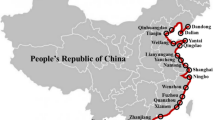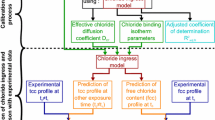Abstract
Concrete structures in an alternate wetting-drying area often suffer from severe chloride ion ingress more than those in other areas. Field tests of marine structures were conducted, and chloride concentration is found to reach a maximum value at a certain elevation. The surface concentration and diffusion coefficient of chloride ions at different elevations exhibit Gaussian unimodal curve distributions. Using the chloride ion unsaturated permeability model, the distribution regularity mechanism is analyzed. Finally, an improved indoor accelerated simulation experiment is proposed to simulate the rules governing chloride ion ingress into concrete structures in an alternate wetting-drying area.
Similar content being viewed by others
References
Vu K A T, Stewart M G. Structural reliability of concrete bridges including improved chloride-induced corrosion models. Struct Saf, 2000, 22: 313–333
Thomas M. Chloride thresholds in marine concrete. Cem Concr Res, 1996, 26: 513–519
Song H W, Lee C H, Ann K Y. Factors influencing chloride transport in concrete structures exposed to marine environments. Cem Concr Compos, 2008, 30: 113–121
Djerbi A, Bonnet S, Khelidj A. Influence of traversing crack on chloride diffusion into concrete. Cem Concr Res, 2008, 38: 877–883
Poursaee A, Hansson C M. Potential pitfalls in assessing chloride-induced corrosion of steel in concrete. Cem Concr Res, 2009, 39: 391–400
Song H W, Ann K Y, Pack S W, et al. Factors influencing chloride transport and chloride threshold level for the prediction of service life of concrete structures. Inter J Struct Eng, 2010, 1: 131–144
Miyagawa T. Durability design and repair of concrete structures: Chloride corrosion of reinforcing steel and alkali-aggregate reaction. Mag Concr Res, 1991, 44: 147–147
Raupach M. Chloride-induced macrocell corrosion of steel in concrete—theoretical background and practical consequences. Constr Build Mater, 1996, 10: 329–338
Refait P H, Abdelmoula M, GÉnin J M R. Mechanisms of formation and structure of green rust one in aqueous corrosion of iron in the presence of chloride ions. Corros Sci, 1998, 40: 1547–1560
Poupard O, Hostis V L, Catinaud S, et al. Corrosion damage diagnosis of a reinforced concrete beam after 40 years natural exposure in marine environment. Cem Concr Res, 2006, 36: 504–520
Guimaraes A T C, Helene P R L. Diffusion of chloride Ions in unsaturated concrete: Forecast of service life in a wet-dry environment. ACI Mater J, 2005, 229: 175–194
Bastidas-Arteaga E, Chateauneuf A, Sánchez-Silva M. A comprehensive probabilistic model of chloride ingress in unsaturated concrete. Eng Struct, 2011, 33: 720–730
Guimarães A T C, Climent M A, Vera G. Determination of chloride diffusivity through partially saturated Portland cement concrete by a simplified procedure. Constr Build Mater, 2011, 25: 785–790
Conciatori D, Sadouki H, Brühwiler E. Capillary suction and diffusion model for chloride ingress into concrete. Cem Concr Res, 2008, 38: 1401–1408
Wang L C. Prediction of chloride ingress into concrete by capillary absorption. Adv Mater Res, 2010, 163–167: 3210–3213
Nilsson L O. Models for chloride ingress into concrete-from Collepardi to today. Inter J Modell, Identification Control, 2009, 7: 129–134
Saetta A V, Scotta R V, Vitaliani R V. Analysis of chloride diffusion into partially saturated concrete. ACI Mater J, 1993, 90: 441–451
China Civil Engineering Standards. CCES01—2004 Concrete Structure Durability Design and Construction Guidelines (in Chinese). Beijing: China Building Industry Press, 2005
General Guidelines for Durability Design and Redesign. DuraCrete, 2000
Andrade C. Calculation of chloride diffusion coefficients in concrete from ionic migration measurements. Cem Concr Res, 1993, 23: 724–742
Tang L P, Nilsson L O. Rapid determination of the chloride diffusivity in concrete by applying an electric Field. ACI Mater J, 1993, 89: 49–53
Thomas M D A, Bamforth P B. Modelling chloride diffusion in concrete: Effect of fly ash and slag. Cem Concr Res, 1999, 29: 487–495
Wee T H, Suryavanshi A K, Tin S S. Evaluation of rapid chloride permeability test (RCPT) results for concrete containing mineral admixtures. ACI Mater J, 2000, 97: 221–232
Zhang T W, Gjørv O E. An electrochemical method for accelerated testing of chloride diffusivity in concrete. Cem Concr Res, 1994, 24: 1534–1548
Detwiler R J, Kjellsen K O, Gjorv O E. Resistance to chloride intrusion of concrete cured at different temperatures. ACI Mater J, 2011, 88: 19–24
Truc O, Ollivier J P, Carcassès M. A new way for determining the chloride diffusion coefficient in concrete from steady state migration test. Cem Concr Res, 2000, 30: 217–226
Snyder K A, Ferraris C, Martys N S. Using impedance spectroscopy to assess the viability of the rapid chloride test for determining concrete conductivity. J Res National Inst Standards Technol, 2000, 105: 497–509
Chatterji S. On the applicability of Fick’s second law to chloride ion migration through portland cement concrete. Cem Concr Res, 1995, 25: 299–303
Maekawa K, Chaube R, Kishi T. Modeling of Concrete Performance. London: E&FN Spon, 1999
Hall C. Water sorptivity of mortars and concretes: A review. Mag Concr Res, 1989, 41: 51–61
Jin W L, Zhang Y, Lu Z Y. Mechanism and mathematic modeling of chloride permeation in concrete under unsaturated state (in Chinese). J Chin Ceramic Society, 2008, 36: 1362–1369
Author information
Authors and Affiliations
Corresponding author
Rights and permissions
About this article
Cite this article
Xu, C., Li, Z., Jin, W. et al. Chloride ion ingress distribution within an alternate wetting-drying marine environment area. Sci. China Technol. Sci. 55, 970–976 (2012). https://doi.org/10.1007/s11431-011-4733-1
Received:
Accepted:
Published:
Issue Date:
DOI: https://doi.org/10.1007/s11431-011-4733-1




